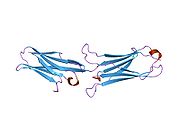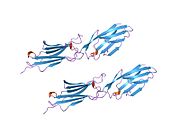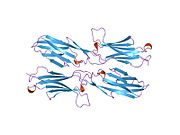VCAM-1
Ensembl | |||||||||
|---|---|---|---|---|---|---|---|---|---|
| UniProt | |||||||||
| RefSeq (mRNA) | |||||||||
| RefSeq (protein) | |||||||||
| Location (UCSC) | Chr 1: 100.72 – 100.74 Mb | Chr 3: 115.9 – 115.92 Mb | |||||||
| PubMed search | [3] | [4] | |||||||
| View/Edit Human | View/Edit Mouse |
Vascular cell adhesion protein 1 also known as vascular cell adhesion molecule 1 (VCAM-1) or cluster of differentiation 106 (CD106) is a protein that in humans is encoded by the VCAM1 gene.[5] VCAM-1 functions as a cell adhesion molecule.
Structure
VCAM-1 is a member of the
Function
The VCAM-1 protein mediates the adhesion of lymphocytes, monocytes, eosinophils, and basophils to vascular endothelium. It also functions in leukocyte-endothelial cell signal transduction, and it may play a role in the development of atherosclerosis and rheumatoid arthritis.
Upregulation of VCAM-1 in endothelial cells by cytokines occurs as a result of increased
Primarily, the VCAM-1 protein is an endothelial
VCAM-1 is also upregulated if vWF (Von Willebrand Factor) is given in knock-out (KO) ADMATS13 mice but not on mice without KO.[8]
CD106 also exists on the surface of some subpopulations of mesenchymal stem cells (MSC).[9]
Pharmacology
Certain melanoma cells can use VCAM-1 to adhere to the endothelium,[10] VCAM-1 may participate in monocyte recruitment to atherosclerotic sites, and it is highly overexpressed in the inflamed brain.[11] As a result, VCAM-1 is a potential drug target.
References
- ^ a b c GRCh38: Ensembl release 89: ENSG00000162692 – Ensembl, May 2017
- ^ a b c GRCm38: Ensembl release 89: ENSMUSG00000027962 – Ensembl, May 2017
- ^ "Human PubMed Reference:". National Center for Biotechnology Information, U.S. National Library of Medicine.
- ^ "Mouse PubMed Reference:". National Center for Biotechnology Information, U.S. National Library of Medicine.
- .
- ^ "Entrez Gene: VCAM1 vascular cell adhesion molecule 1".
- ^ PMID 12082081.
- PMID 27501520.
- PMID 23555021.
- PMID 16475855.
- PMID 32005712.
Further reading
- Yonekawa K, Harlan JM (2005). "Targeting leukocyte integrins in human diseases". J. Leukoc. Biol. 77 (2): 129–40. PMID 15548573.
- Wu TC (2007). "The role of vascular cell adhesion molecule-1 in tumor immune evasion". Cancer Res. 67 (13): 6003–6. PMID 17616653.



